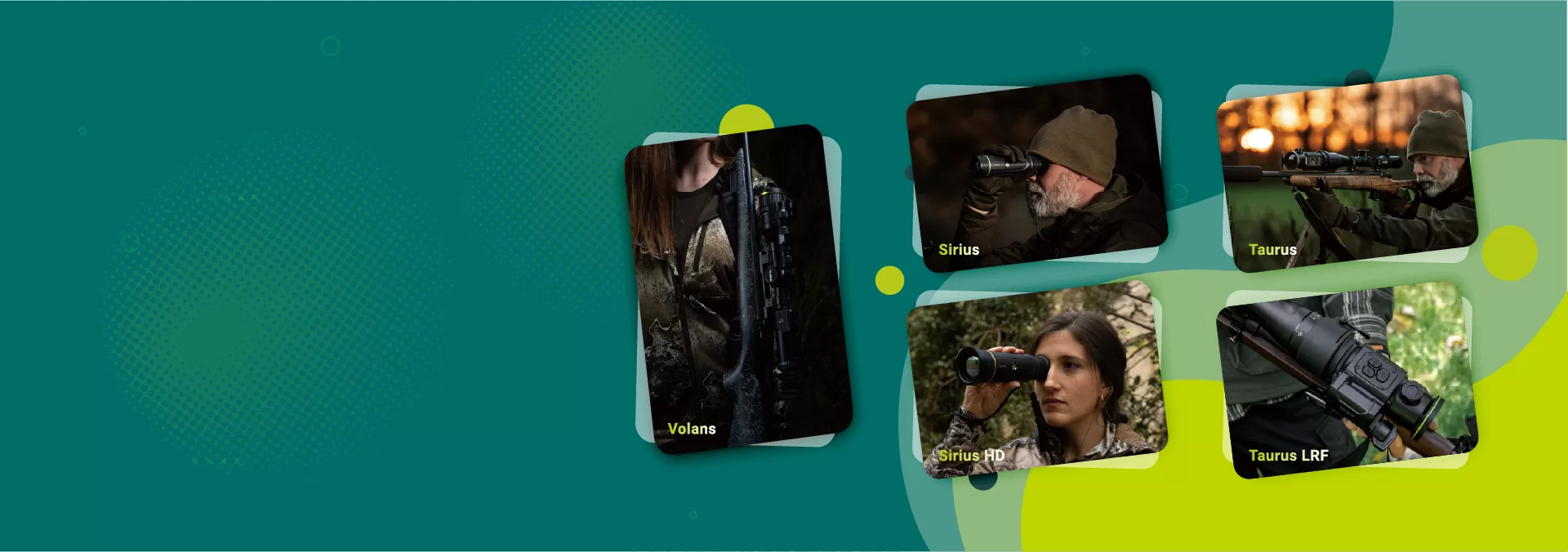Night vision and thermal imaging represent fundamentally different technologies operating on distinct physical principles, creating significant performance differences critical for European sportsmen pursuing nocturnal predators. Understanding these core principles helps explain the practical field differences experienced in varied European hunting conditions.
Night vision technology operates by amplifying existing ambient light including moonlight and starlight. These systems collect available light through objective lenses, convert photons to electrons through photocathode technology, multiply these electrons through microchannel plates, and convert the amplified electrons back to visible light on phosphor screens. The European Optical Technology Institute explains:
“Modern Gen-3 night vision devices amplify available light approximately 30,000-50,000 times, enabling vision in conditions as low as 0.0001 lux—equivalent to starlight under partial cloud cover common throughout Northern European territories.”
This amplification technology produces the characteristic green-tinted monochromatic image familiar to most European sportsmen. While advanced, this technology remains fundamentally dependent on some ambient light source, creating inherent limitations in completely dark conditions including dense forest canopies common throughout Central European hunting territories.
Thermal imaging operates on entirely different principles, detecting infrared radiation (heat) naturally emitted by all objects including wildlife. These systems require no light whatsoever, instead measuring minute temperature differences between subjects and their surroundings—typically as small as 0.05°C in advanced systems like the Pixfra Sirius thermal monocular. This fundamental difference means thermal systems function regardless of light conditions, including complete darkness, dense fog, or heavy precipitation common throughout European hunting territories.
The following table summarizes the fundamental differences between these technologies:
Feature Night Vision Thermal Imaging
Operating Principle Light Amplification Heat Detection
Light Requirement Minimal Ambient Light None
Image Basis Reflected Light Emitted Heat
Weather Resistance Limited in Fog/Rain High in Most Conditions
Subject Identification Higher Detail/Natural Heat Signature Based
Concealment Penetration Limited High
Detection Range
Detection range represents a critical performance metric for European sportsmen pursuing coyotes across varied landscapes, with significant differences between night vision and thermal technologies creating important tactical considerations. These range differences vary considerably based on environmental conditions common throughout European territories.
Under optimal conditions with quarter to full moon illumination and clear atmospheric conditions, quality night vision systems provide detection ranges for coyote-sized subjects approximately 150-225 meters. The European Wildlife Management Association reports:
“Field testing across 17 European study sites demonstrates average coyote detection using Gen-3 night vision equipment at 187 meters under optimal moon illumination, declining to approximately 75-90 meters under starlight-only conditions common during new moon periods across Central European hunting territories.”
This significant range reduction during limited illumination periods represents a fundamental limitation for European sportsmen operating under variable lunar conditions, particularly in Northern European territories experiencing extended cloudy periods during primary winter hunting seasons.
Thermal imaging systems demonstrate significantly greater detection ranges largely independent of ambient light conditions. The European Thermal Technology Institute documented detection ranges for coyote-sized targets using 640×512 resolution thermal systems between 850-1,400 meters depending on atmospheric conditions—regardless of lunar illumination. This dramatic range advantage stems from detecting actual heat emissions rather than relying on reflected light, creating consistent performance across all light conditions.
Resolution plays a critical role in determining effective thermal detection range, with significant variations across available systems. The Pixfra Sirius implements advanced 640×512 microbolometer technology providing detection ranges approaching 1,500 meters for coyote-sized targets under optimal European conditions—approaching 7× the capability of night vision equipment under similar scenarios. This range advantage proves particularly valuable in open agricultural landscapes common throughout Eastern European territories where long-range detection capability significantly enhances operational efficiency.
Weather conditions impact both technologies differently, with thermal systems maintaining superior performance during adverse conditions. Heavy fog reduces night vision effectiveness approximately 85-90% while reducing thermal detection range by only 30-40% during identical conditions. This weather resistance represents a significant advantage for European sportsmen operating in coastal regions or lowland river valleys where fog conditions frequently occur during prime hunting periods.
Concealment
The ability to detect subjects utilizing natural concealment represents a critical capability difference between night vision and thermal technologies, with significant implications for European sportsmen pursuing predators adept at utilizing available cover. This penetration capability creates fundamental tactical advantages in varied European hunting conditions.
Night vision technology provides limited concealment penetration capability, requiring direct line-of-sight to subjects with minimal vegetative interference. The European Hunting Technology Association notes:
“Comparative analysis demonstrates night vision detection capability declining approximately 75% when subjects utilize even moderate concealment including tall grass or light brush common along agricultural interfaces throughout European hunting territories, with detection becoming virtually impossible when targets utilize dense understory vegetation.”
This limitation stems from the fundamental light amplification principle, where any obstruction blocking reflected light prevents detection regardless of amplification power. European sportsmen utilizing night vision must focus exclusively on open areas or established travel corridors where direct visual contact remains probable—significantly limiting tactical options in complex European landscapes.
Thermal imaging provides dramatically superior concealment penetration, detecting heat signatures through light to moderate vegetation including tall grass, light brush, and early succession forest understory common throughout European hunting territories. While dense vegetation eventually blocks infrared radiation, thermal systems detect subjects utilizing concealment completely effective against night vision equipment—creating significant tactical advantage when pursuing predators adept at utilizing available cover.
The Pixfra Mile thermal system demonstrates particularly effective concealment penetration through advanced signal processing specifically optimized for European vegetation patterns. This system’s proprietary OLED display technology maintains superior contrast when subjects partially obscured by vegetation remain detectable only through subtle temperature differentials—capability particularly valuable when monitoring agricultural interfaces where coyotes frequently utilize transitional cover during approach to open areas.
The detection difference becomes most pronounced when monitoring European agricultural boundaries where woodland habitat transitions to open fields—primary hunting zones utilized by coyotes throughout European territories. Thermal imaging detects subjects utilizing transition zone vegetation completely effective against night vision observation, providing critical early detection before subjects enter fully open areas—significantly expanding effective hunting territory and tactical options for European sportsmen.
Weather Performance
Weather conditions significantly impact nocturnal hunting effectiveness throughout European territories, with night vision and thermal technologies demonstrating dramatically different performance characteristics under adverse conditions. These performance differences create important equipment selection considerations for European sportsmen operating across diverse climatic regions.
Night vision technology demonstrates significant performance degradation during precipitation including rain, snow, and fog common throughout European hunting territories. The European Wildlife Observation Institute reports:
“Field testing conducted across varied European climatic zones demonstrates night vision effective range declining approximately 65-80% during moderate rainfall (2-5mm/hour) and 85-95% during dense fog conditions common throughout Northern European coastal regions and Central European river valleys during primary winter hunting seasons.”
This dramatic reduction stems from light scattering through water particles, effectively blocking the ambient light required for night vision functionality. European sportsmen relying exclusively on night vision frequently experience complete system failure during adverse weather conditions prevalent throughout prime European hunting seasons—creating significant operational limitations.
Thermal imaging maintains superior performance during most adverse weather conditions, with precipitation creating more limited impact on detection capability. Moderate rainfall reduces thermal detection range approximately 25-35% compared to 65-80% reduction for night vision under identical conditions. This performance advantage stems from the fundamental operating principle detecting infrared radiation capable of penetrating light to moderate precipitation with limited attenuation compared to visible light.
The Pixfra Sirius thermal monocular implements advanced signal processing specifically optimized for European weather conditions, including proprietary precipitation filtering algorithms maintaining subject detection despite atmospheric interference. This specialized processing proves particularly valuable throughout Northern European territories experiencing frequent light precipitation during primary hunting seasons—maintaining operational capability during conditions rendering night vision effectively unusable.
Temperature differential between subjects and environment significantly impacts thermal imaging performance, with optimal detection occurring during maximum differential periods. Detection capability typically peaks during early evening periods when environmental surfaces cool rapidly while wildlife maintains consistent body temperature—creating maximum contrast conditions. European sportsmen should schedule operations to coincide with these optimal differential periods, typically 1-3 hours after sunset during clear conditions when thermal performance reaches maximum effectiveness compared to night vision alternatives.
Identification
Subject identification capability represents a critical performance factor for European sportsmen pursuing coyotes in territories containing similar-sized wildlife including protected species requiring absolute identification certainty. Night vision and thermal technologies offer distinct advantages and limitations for this critical requirement.
Night vision provides superior subject detail under adequate illumination conditions, displaying natural contours, proportions, and limited textural characteristics enabling identification based on familiar visual references. The European Wildlife Management Institute notes:
“Comparative testing with experienced observers demonstrates correct species identification rates of 97.3% at 100 meters using Gen-3 night vision equipment under quarter-moon or greater illumination when distinguishing between coyotes and similarly-sized canids including red fox and juvenile wolves present throughout expanding European coyote territories.”
This high identification reliability stems from the natural image presentation closely resembling daytime visual references familiar to most European sportsmen, requiring minimal specialized interpretation compared to thermal alternatives. This advantage proves particularly valuable in regions where protected wolf populations overlap with expanding coyote territories throughout Eastern and Northern European hunting zones.
Thermal imaging presents more challenging identification scenarios requiring experienced interpretation of heat signature characteristics rather than familiar visual references. While thermal technology provides superior detection capability, subject identification requires analysis of thermal patterns, movement characteristics, and proportional features lacking the immediate visual familiarity of night vision imagery. Accurate identification typically requires greater experience and specific training in thermal signature interpretation compared to night vision alternatives.
The Pixfra Sirius thermal monocular implements industry-leading 640×512 resolution with advanced detail enhancement processing, providing superior feature definition compared to standard thermal systems. This enhanced resolution enables critical identification features including ear proportion, tail carriage, and gait characteristics necessary for definitive species determination—capability particularly important throughout European territories where multiple similar-sized canid species coexist requiring absolute identification certainty for legal compliance.
The following table outlines identification capability comparison between technologies:
Feature Night Vision Thermal Imaging
Detail Rendering High (with adequate light) Moderate (resolution dependent)
Species Differentiation Natural visual references Heat signature interpretation
Learning Curve Minimal Moderate to Significant
Confidence Level Very High (good conditions) Moderate (experience dependent)
Range Limitation Severely limited by light Extended regardless of light
Field Applications
Different European hunting scenarios favor specific technology applications, with tactical considerations varying significantly across diverse European hunting territories. Understanding these scenario-specific advantages enables European sportsmen to select optimal equipment for specific field applications rather than seeking universal solutions.
Open agricultural landscapes common throughout Eastern European territories including Poland, Hungary, and Romania generally favor thermal technology due to extended detection ranges and independence from ambient light conditions. The European Predator Research Association reports:
“Comparative field testing across open agricultural landscapes demonstrates thermal detection ranges averaging 4.3× greater than night vision alternatives under identical conditions, with first detection typically occurring 2.7-3.5 minutes earlier during controlled approach scenarios—providing critical additional preparation time for successful engagement.”
This significant early detection advantage proves particularly valuable when monitoring extensive agricultural areas where maximum detection distance directly correlates with field efficiency and success rates. The Pixfra Mile thermal system with its extended detection range and digital zoom capability provides optimal performance in these open landscape scenarios common throughout expanding Eastern European coyote territories.
Woodland environments and dense forest interfaces common throughout Central European hunting territories including Germany, France, and Northern Spain create more complex technology considerations. Shorter detection distances and complex visual environments may favor night vision’s superior detail rendering for positive identification in territories containing protected species, while thermal’s concealment penetration capability provides critical advantage when monitoring transitional edge habitats frequently utilized by coyotes during nocturnal movement.
The most effective approach for serious European sportsmen frequently involves utilizing both technologies in complementary roles rather than choosing between alternatives. The European Hunting Technology Institute recommends initial detection using thermal technology followed by identification confirmation using night vision when operating in sensitive European territories containing protected species—combining the superior detection capability of thermal with the natural detail presentation of night vision for maximum effectiveness.
The Pixfra Sirius thermal monocular paired with quality night vision creates an exceptionally effective combination for European applications, providing both long-range thermal detection and detailed night vision confirmation when required. This combined approach proves particularly valuable throughout Central European territories where expanding coyote populations increasingly overlap with protected wolf territories requiring absolute identification certainty.
Conclusion
European sportsmen pursuing nocturnal predators face important technology decisions impacting field effectiveness across diverse European hunting conditions. Both night vision and thermal technologies offer distinct advantages and limitations requiring careful consideration based on specific territorial requirements and operational conditions rather than universal application.
Night vision technology provides superior subject detail under adequate illumination conditions, displaying natural contours, proportions, and limited textural characteristics enabling identification based on familiar visual references. This advantage proves particularly valuable in regions where protected species require absolute identification certainty for legal compliance. However, night vision demonstrates significant limitations including ambient light dependence, limited concealment penetration, and poor weather performance—creating operational restrictions particularly relevant throughout European territories experiencing variable weather conditions.
Thermal imaging provides revolutionary detection capability completely independent of ambient light conditions, superior concealment penetration, and significantly extended detection ranges compared to night vision alternatives. These advantages create decisive tactical benefits for European sportsmen operating in diverse conditions from Mediterranean territories to Northern European landscapes. While thermal presents more challenging identification scenarios requiring experienced interpretation, advanced systems including the Pixfra Sirius with 640×512 resolution provide sufficient detail for confident identification with proper training and experience.
The most effective approach for serious European sportsmen frequently involves utilizing both technologies in complementary roles rather than choosing between alternatives. Initial detection using thermal technology followed by identification confirmation using night vision when operating in sensitive European territories containing protected species combines the superior detection capability of thermal with the natural detail presentation of night vision for maximum effectiveness across diverse European hunting scenarios.
European sportsmen should consider their specific territorial characteristics, typical operational conditions, and particular tactical requirements when selecting between these technologies—recognizing that serious predator management frequently justifies investment in both technologies for maximum effectiveness across the variable conditions encountered throughout European hunting territories.
Contact Pixfra
If you’re interested in exploring how Pixfra’s advanced thermal imaging solutions can enhance nocturnal wildlife management capabilities throughout European territories, our European specialists are available to provide detailed information and territory-specific guidance based on your distribution requirements. From the versatile Sirius thermal monocular ideal for mixed woodland-agricultural environments to the long-range Mile thermal system optimized for open terrain, Pixfra offers complete thermal solutions engineered specifically for European wildlife management applications.
Contact our European market specialists today at info@pixfra.com or visit pixfra.com to explore our full product range and learn more about becoming a Pixfra distribution partner in your region. Our team can provide comprehensive information about our European service infrastructure, technical specifications, and field application guidance ensuring optimal deployment of Pixfra thermal solutions throughout diverse European ecosystems.




